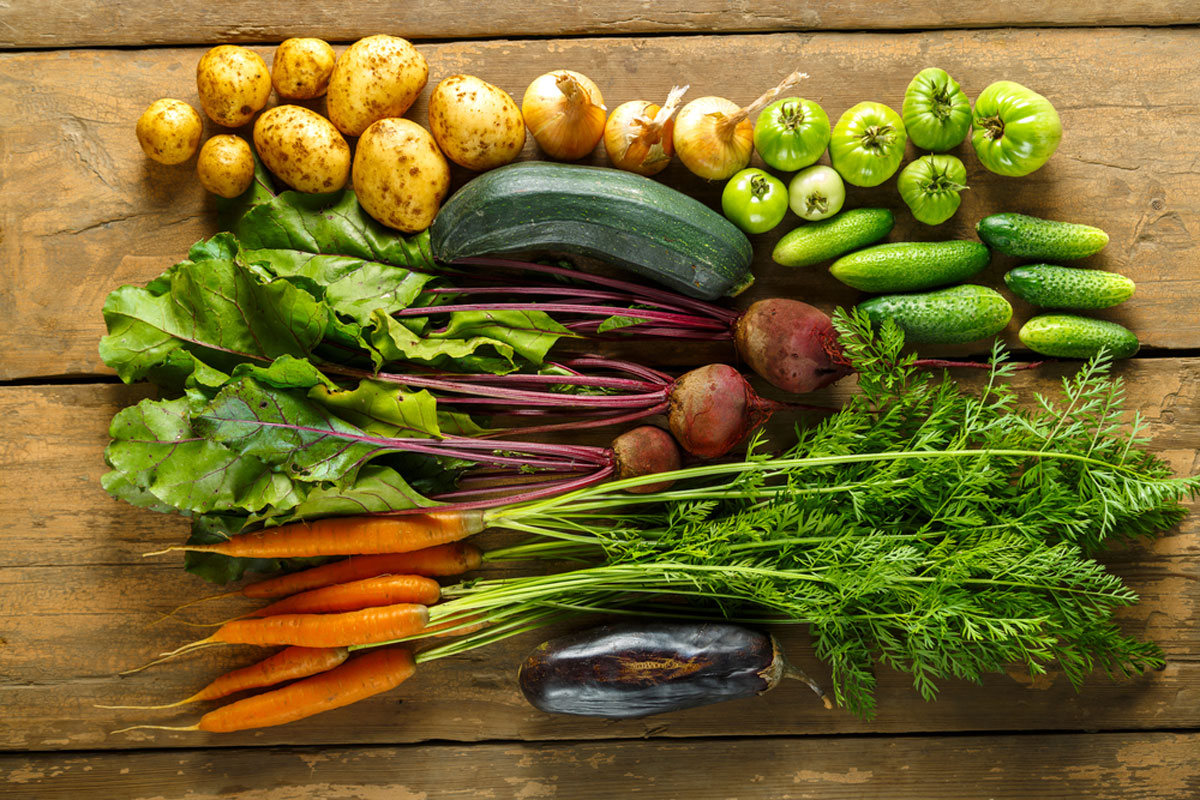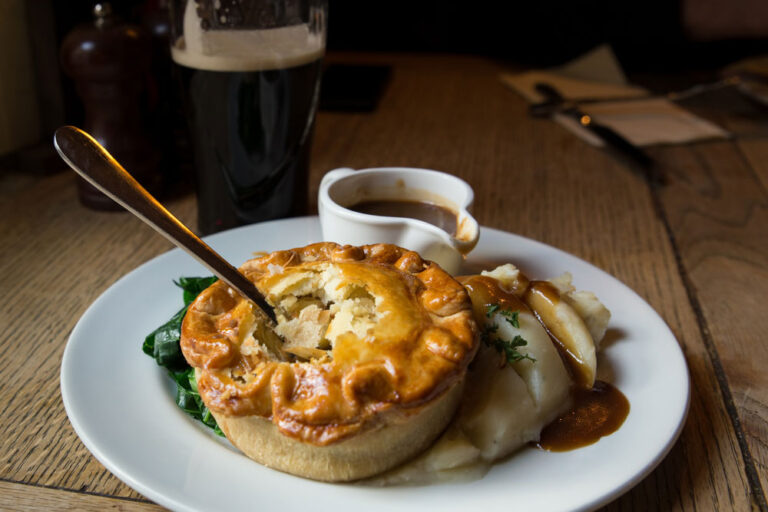Spring (March-May)
Spring in Ireland marks the beginning of renewal, with the landscape awakening after the long winter months. The days grow longer, and the first signs of life begin to emerge from the soil. This season is characterized by fresh, tender vegetables and herbs, along with the arrival of early lamb, all of which are hallmarks of Irish spring cuisine.
What’s Fresh in Spring:
1. Asparagus: One of the first vegetables to appear, Irish-grown asparagus is tender and flavorful. The season is short, so it’s best enjoyed fresh.
2. Early Potatoes: Known for their delicate skins and creamy texture, new potatoes are a staple of the Irish spring table.
3. Spring Onions: These mild, sweet onions add a burst of freshness to dishes and are perfect for garnishing salads, soups, and stir-fries.
4. Rhubarb: With its bright, tangy flavor, rhubarb is a spring favorite, especially in desserts.
5. Wild Garlic: Found in woodlands, wild garlic has a distinctive flavor that’s less pungent than regular garlic. Its leaves and flowers are edible and versatile in many dishes.
6. Herbs: Fresh herbs like mint, parsley, and chives start to flourish, adding vibrant flavors to spring meals.
7. Lamb: Spring lamb is tender and flavorful, perfect for hearty meals as the weather remains unpredictable.
Culinary Traditions and Recipes:
Spring eating in Ireland is about celebrating the freshness and delicate flavors of the season. With these ingredients, you can create simple yet delicious dishes that reflect the best of what’s available.
- Spring Vegetable Soup: A light and flavorful soup made with new potatoes, spring onions, asparagus, and fresh herbs. The vegetables are simmered gently to retain their vibrant color and flavor.
- Rhubarb Tart: A traditional dessert, this tart combines the tartness of rhubarb with a sweet, buttery pastry. Served with a dollop of cream, it’s a perfect finish to any meal.
- Roast Lamb with Wild Garlic: A celebration of spring, roast lamb seasoned with wild garlic leaves is a dish that combines tenderness and robust flavor. Paired with new potatoes, it’s a quintessential Irish spring meal.
Foraging and Sustainability:
Spring is also an ideal time to start foraging for wild ingredients like wild garlic and nettles. Foraging connects you with nature and provides unique flavors that can’t be found in shops. Sustainable eating is rooted in consuming what’s locally available and reducing waste. By focusing on in-season ingredients, you support local farmers and enjoy produce at its peak freshness.
Spring in Ireland is a time of renewal, both in nature and on the plate. The season’s fresh ingredients provide a delicious introduction to the year’s bounty, offering a preview of what’s to come. As you embrace the flavors of spring, you connect with the rhythms of the Irish landscape and its rich culinary traditions.
Summer (June-August)
Summer in Ireland is a time of abundance, where the country’s fields, gardens, and coastlines offer up a rich variety of fresh produce and seafood. The long days and warm weather allow fruits and vegetables to flourish, making it the perfect season to enjoy the bounty of the land. With the harvest of berries, greens, and vibrant vegetables, alongside fresh seafood, Irish summer cuisine is bright, refreshing, and full of flavor.
What’s Fresh in Summer:
1. Berries: Irish strawberries, raspberries, and blackberries are sweet and juicy, reaching their peak ripeness in the summer months. Perfect for desserts, snacks, or even savory dishes.
2. New Potatoes: While available in spring, new potatoes are at their best in early summer. Their waxy texture and delicate flavor make them a versatile ingredient.
3. Peas: Fresh garden peas and sugar snap peas are sweet and crisp, ideal for salads, stir-fries, or simply eaten fresh from the pod.
4. Tomatoes: Homegrown tomatoes come into season in the summer, offering rich, sweet flavors far superior to their off-season counterparts.
5. Courgettes (Zucchini): These summer squash are tender and mild, perfect for grilling, roasting, or incorporating into light summer dishes.
6. Seafood: Ireland’s coasts yield an array of fresh seafood in the summer, including mackerel, crab, and lobster. These are best enjoyed simply prepared, allowing their natural flavors to shine.
Culinary Traditions and Recipes:
Summer eating in Ireland is about celebrating the natural sweetness and freshness of seasonal ingredients. Light, simple preparations that highlight the purity of the produce are key to summer meals.
- Summer Salad: A vibrant salad featuring fresh peas, new potatoes, and garden greens, topped with herbs like mint and parsley. Add a few slices of ripe tomatoes and drizzle with a light vinaigrette for a refreshing dish.
- Berry Crumble: A classic dessert that’s a favorite in Irish homes, the berry crumble combines the sweetness of summer berries with a buttery, crumbly topping. Serve with cream or ice cream for an indulgent treat.
- Grilled Mackerel with Lemon and Herbs: Freshly caught mackerel, seasoned with lemon, garlic, and herbs, and grilled to perfection. This dish is simple but flavorful, letting the freshness of the fish shine through.
Preserving the Season:
Summer’s abundance also invites thoughts of preservation. Berries can be turned into jams, tomatoes can be canned, and herbs can be dried or frozen for use in the colder months. Preserving allows you to enjoy the taste of summer year-round and is a traditional practice in Irish households, where the goal was often to prepare for the leaner winter months.
Farmers’ Markets and Local Produce:
Summer is the perfect time to visit local farmers’ markets, where you can find the freshest produce and seafood. Supporting local farmers ensures that you are eating the best seasonal ingredients while also contributing to the local economy. The summer months often see a burst of activity at markets, with stalls brimming with colorful fruits, vegetables, and artisanal products.
Summer in Ireland is a time to savor the richness of the season’s harvest. The variety of fresh fruits, vegetables, and seafood available during these months offers endless possibilities for delicious and healthy meals. By focusing on what’s fresh and local, you not only enjoy the best flavors but also support sustainable eating practices. As you explore the tastes of an Irish summer, you’ll discover the joy of eating in harmony with the seasons.
Autumn (September-November)
Autumn in Ireland is a season of plenty, marked by the harvest of a wide range of fruits, vegetables, and grains. As the days grow shorter and the air turns crisp, the focus shifts to heartier, more robust flavors. This is the time for comfort foods that nourish and sustain as the weather cools. The landscape is ablaze with color, and so are the markets, filled with autumn produce that reflects the richness of the season.
What’s Fresh in Autumn:
1. Apples: Irish apples are plentiful in autumn, ranging from sweet to tart varieties. They are perfect for baking, cooking, or enjoying fresh.
2. Pumpkins and Squash: These versatile vegetables are at their peak in autumn. They can be roasted, pureed into soups, or used in pies and other baked goods.
3. Root Vegetables: Carrots, parsnips, turnips, and beetroots are all in season, offering earthy, sweet flavors that are ideal for roasting, mashing, or adding to stews.
4. Cabbage and Kale: These leafy greens thrive in the cooler weather, providing nutritious and hardy options for soups, stews, and side dishes.
5. Mushrooms: Wild mushrooms, such as chanterelles and porcini, can be foraged in Irish woodlands during autumn, offering rich, umami flavors to dishes.
6. Game Meats: Autumn is also the season for game such as venison, wild boar, and pheasant, which bring a deep, rich taste to meals.
Culinary Traditions and Recipes:
Autumn in Ireland is synonymous with harvest celebrations and a focus on dishes that provide warmth and comfort. The flavors are deeper, and the cooking methods often involve slow roasting, braising, and baking.
- Apple Pie: A classic Irish dessert, apple pie combines the season’s fresh apples with a buttery, flaky crust. Spices like cinnamon and nutmeg enhance the flavors, making it a perfect end to any meal.
- Pumpkin Soup: Creamy and comforting, pumpkin soup is an autumn staple. It can be flavored with garlic, onions, and a hint of nutmeg, then topped with roasted seeds for a satisfying crunch.
- Slow-Cooked Game Stew: This hearty dish features game meat such as venison, along with root vegetables like carrots and parsnips. Slowly braised in red wine or stock, it’s a meal that warms both body and soul.
Preserving the Autumn Harvest:
Autumn is traditionally a time for preserving the harvest to ensure a supply of food during the winter months. Apples can be turned into cider, chutney, or applesauce. Root vegetables can be stored in cool, dark places, and cabbage can be fermented into sauerkraut. These preservation methods not only extend the life of your produce but also add variety to your winter diet.
Foraging and Seasonal Awareness:
Foraging plays an important role in autumn, especially with the availability of wild mushrooms, blackberries, and elderberries. These wild foods add unique flavors to your cooking and connect you to the land. Being aware of what’s in season also means you can make the most of the fresh produce available, ensuring your meals are as flavorful and nutritious as possible.
Autumn in Ireland is a celebration of the harvest, a time to embrace the bounty of the land and the richness of seasonal flavors. The season’s produce is robust and versatile, lending itself to comforting dishes that warm the heart. By focusing on what’s fresh and in season, you can create meals that are not only delicious but also reflective of Ireland’s culinary heritage. As the days grow cooler, let the tastes of autumn bring warmth and sustenance to your table.

Winter (December-February)
Winter in Ireland is a season of hearty, warming foods that provide comfort against the cold and darkness of the shorter days. While the variety of fresh produce narrows compared to the abundance of autumn, winter is still a time to celebrate the robust and nourishing flavors that can be drawn from the land. Root vegetables, brassicas, and preserved foods take center stage, along with meats and dairy that provide sustenance during the colder months.
What’s Fresh in Winter:
1. Root Vegetables: Carrots, parsnips, potatoes, turnips, and swedes (rutabagas) are all at their best during winter. Their natural sweetness deepens when roasted or slow-cooked.
2. Cabbage and Kale: Hardy greens like cabbage, kale, and Brussels sprouts thrive in the cold, offering vital nutrients and a crisp bite to winter dishes.
3. Leeks: With their mild, onion-like flavor, leeks are a versatile winter vegetable that adds depth to soups, stews, and casseroles.
4. Jerusalem Artichokes: These knobby tubers have a nutty, sweet flavor and are perfect for roasting or pureeing into soups.
5. Brussels Sprouts: Often unfairly maligned, Brussels sprouts are delicious when roasted, sautéed, or even shaved raw into salads.
6. Meats: Winter is the season for rich, slow-cooked meats like beef, pork, and lamb, as well as cured or preserved meats that provide warmth and sustenance.
Culinary Traditions and Recipes:
Winter cuisine in Ireland is all about comfort, using slow-cooking methods that extract deep flavors from simple ingredients. Dishes are often hearty, designed to warm the body and soul during the colder months.
- Irish Stew: A classic winter dish, Irish stew is made with lamb or mutton, potatoes, carrots, and onions. Slow-cooked until tender, it’s a simple but deeply satisfying meal that has been a staple of Irish kitchens for generations.
- Colcannon: A comforting side dish made from mashed potatoes mixed with sautéed cabbage or kale. It’s creamy, buttery, and perfect alongside roasted meats or sausages.
- Roasted Root Vegetables: A mix of carrots, parsnips, and Jerusalem artichokes roasted with olive oil, garlic, and rosemary. The roasting process brings out the natural sweetness of the vegetables, making them a delicious and easy winter side.
Preservation and Sustainability:
Winter is also a time when preservation methods come into their own. Fermented vegetables like sauerkraut, pickled beets, and preserved cabbage add flavor and nutrition to meals. Cured meats, smoked fish, and homemade stocks become essential, ensuring that there’s always something nourishing on hand even when fresh produce is scarce.
Winter Markets and Local Produce:
While the produce available in winter may be less varied, local farmers’ markets continue to offer seasonal ingredients, as well as artisanal breads, cheeses, and preserved foods that enhance winter meals. Supporting local producers during the winter months helps sustain the local food economy and ensures you have access to high-quality, fresh products.
Winter in Ireland is a time to embrace the comfort of hearty, nourishing foods that sustain both body and spirit. Though the season may be leaner in terms of variety, the depth of flavor in winter produce is rich and satisfying. By focusing on what’s fresh and in season, you can create meals that are both delicious and reflective of the rhythms of the Irish landscape. As you gather around the table during these cold months, let the warmth of winter’s bounty bring comfort and joy to your meals.
Year-Round Sustainability
As the seasons change, so too does the availability of fresh produce in Ireland. Eating seasonally means embracing the natural rhythms of the year, enjoying food at its peak freshness, and supporting local farmers and producers. But what does seasonal eating look like across an entire year, and how can you sustain this practice year-round? Now let us explore the broader concept of seasonal eating, highlighting how you can make the most of what’s available in each season while also considering sustainability and mindful consumption.
The Benefits of Seasonal Eating:
1. Flavor and Nutrition: Produce that’s harvested in season is fresher, more flavorful, and often more nutritious. Seasonal foods are picked at their peak, resulting in better taste and higher nutrient content.
2. Environmental Impact: Eating seasonally reduces the need for long-distance transportation, cutting down on carbon emissions. It also supports more sustainable farming practices that align with natural growing cycles.
3. Supporting Local Economies: By choosing local, seasonal produce, you directly support Irish farmers and the local economy. This also ensures that your food is fresher and hasn’t traveled long distances.
Strategies for Year-Round Seasonal Eating:
1. Plan and Preserve: Take advantage of the abundance of each season by preserving foods for later use. In summer, you can freeze or can berries, tomatoes, and herbs. In autumn, make jams, pickles, or store root vegetables in a cool, dark place.
2. Foraging and Wild Foods: Foraging for wild foods like mushrooms, berries, and herbs connects you to the land and adds variety to your diet. Learn what’s available and when, and always forage responsibly.
3. Embrace Versatile Staples: Certain foods are available year-round, like dairy products, eggs, and grains. Use these as the foundation of your meals, adding seasonal vegetables, fruits, and meats as they become available.
4. Grow Your Own: Even a small garden or a few potted herbs can provide fresh produce throughout the year. Consider growing hardy winter greens, herbs, or even root vegetables that can be harvested in late autumn and early winter.
5. Mindful Shopping: Visit farmers’ markets regularly to see what’s in season. Local markets are a great way to discover fresh, seasonal ingredients and to try new varieties of fruits and vegetables.
Culinary Inspirations for Every Season:
- Spring: Light and fresh dishes featuring early vegetables, new potatoes, and lamb. Think salads, simple soups, and grilled meats with fresh herbs.
- Summer: Vibrant and colorful meals using berries, tomatoes, and fresh seafood. Consider salads, grilled vegetables, and cold soups.
- Autumn: Hearty and comforting dishes that celebrate the harvest. Focus on root vegetables, apples, and game meats, with slow-cooked stews and baked goods.
- Winter: Warming and robust meals featuring root vegetables, hardy greens, and preserved foods. Think stews, casseroles, and roasted dishes.
Embracing Sustainability Beyond the Kitchen:
Sustainability isn’t just about what you eat; it’s also about how you live. Consider composting kitchen waste, reducing food waste by planning meals carefully, and choosing reusable containers and bags when shopping. Eating seasonally and locally also reduces the demand for out-of-season produce that requires energy-intensive greenhouse production or long-haul transportation.
Year-round seasonal eating in Ireland is more than just a way of sourcing food; it’s a way of connecting with the land, supporting local communities, and living sustainably. By focusing on what’s fresh and available in each season, you not only enjoy food at its best but also contribute to a healthier environment and a stronger local economy. As you move through the seasons, let the natural rhythm of Irish produce guide your meals, bringing variety, flavor, and sustainability to your table all year long.







